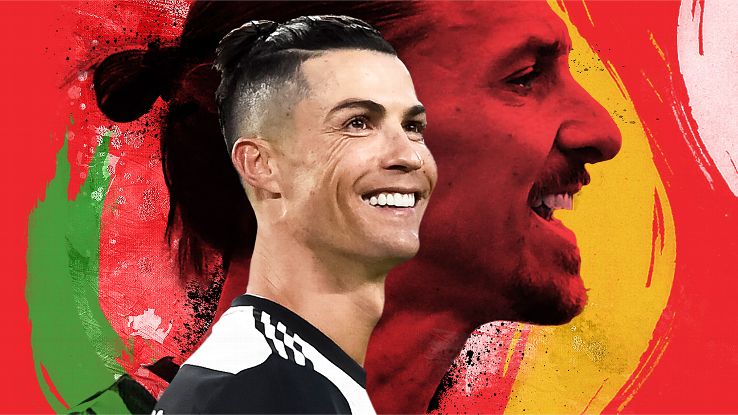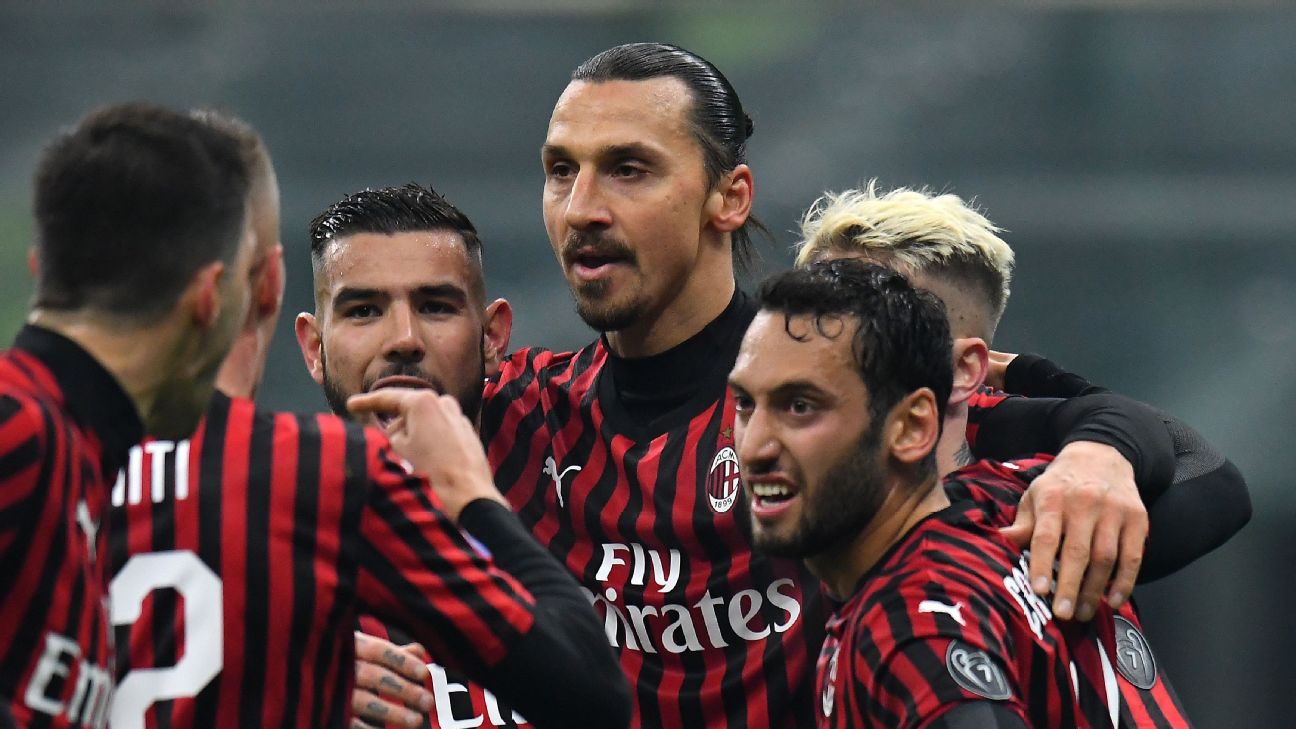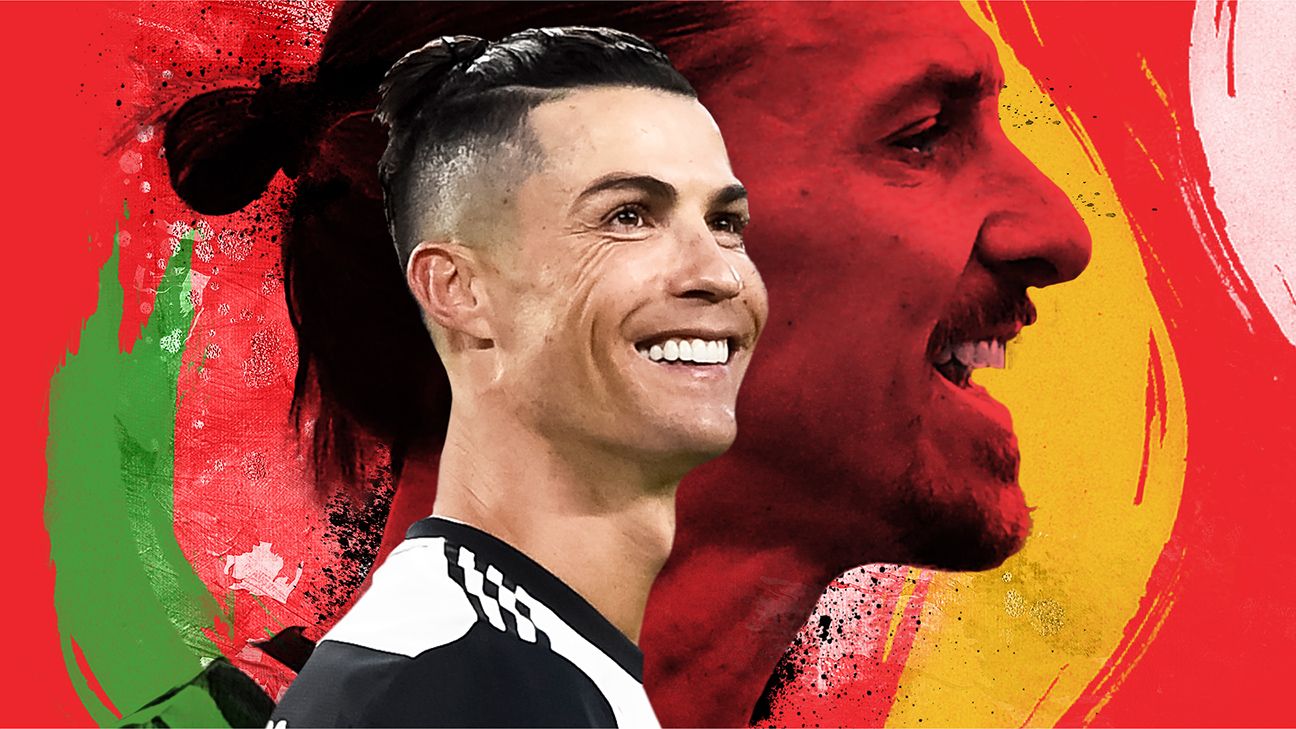Products You May Like

On Thursday, two of the most prolific goal scorers of their generation will meet for the ninth time in their respective careers. AC Milan host Juventus in the first leg of the Coppa Italia semifinals — stream live on ESPN+, 2:45 p.m. ET Thursday — and that means 38-year-old recent Milan signing (well, re-signing) Zlatan Ibrahimovic and 35-year-old second-year Juve striker Cristiano Ronaldo will face off for the first time since November 2015.
Ronaldo and Ibrahimovic have played each other eight times at the club level: six times in the Champions League and twice in La Liga, when Zlatan was with Barcelona. These matches resulted in three draws, three wins for Ronaldo, two wins for Ibrahimovic and just three combined goals for the two strikers. The matchup itself is not without short-term consequence. Winning the Coppa Italia might represent Milan’s best chance to qualify for European competition next year, and the whole point of Juve signing Ronaldo was to win countless trophies. Still, Thursday’s battle is more interesting for the big-picture perspective than anything else.
Aside from their goal-scoring capabilities — the two combined for upward of 800 goals in the 2010s (admittedly, about two-thirds of that total came from Ronaldo) — these two strikers don’t have a ton in common. Ronaldo has played for just three clubs in the past 17 years (Manchester United, Real Madrid and, for the past season-and-a-half, Juventus), and Ibrahimovic has primarily been a hired gun, playing for more than three seasons with one club just once (Paris Saint-Germain, 2012-16). Ronaldo has won both the Champions League and the Ballon d’Or five times each; Ibrahimovic has zero of either.
— Stream LIVE: Inter vs. Napoli, 2:45 p.m. ET Wednesday, ESPN+
— Stream LIVE: AC Milan vs. Juventus, 2:45 p.m. ET Thursday, ESPN+
Juventus’ acquisition of Ronaldo was the grandest of gestures, costing more than £100 million and bringing enormous expectations. Milan’s goals in bringing in Ibrahimovic were far more modest. In the end, there’s a chance that we look at the latter move as more successful than the former.
It’s all about where you set the bar.
It was clear that, in signing Ronaldo, Juventus were thinking beyond Italy

The Bianconeri won seven Serie A titles in a row without CR7, and they won another last spring. Yet they haven’t won the Champions League since 1996. Since beating Ajax in penalties that year in the final, they’ve lost in the finals five times (1997, 1998, 2003, 2015, 2017). They lost in the quarterfinals or later in four of the six years prior to Ronaldo’s signing. Juventus have been unable to get over the hump, and acquiring the face of the Real Madrid team that defeated them in this competition in 2014, 2017 and 2018 seemed like the most direct path to Champions League glory.
This seemed like the perfect way to take a step forward … but then Juve were upset by Ajax in the Champions League quarterfinals last year. As they await their UCL round-of-16 matchup with Lyon in a couple of weeks, they find themselves in a sudden fight for Serie A, tied with Inter Milan on points and only one ahead of red-hot Lazio, the team with the best goal differential and expected goal differential in the league. FiveThirtyEight’s club soccer ratings still give Juve a 58% chance to win the league, but those odds have shrunk the past two months. Meanwhile, their Champions League odds? Three percent, same as Atalanta’s. Two years ago, before Ronaldo, they headed into the knockout stage with an 8% chance to win.
It’s fair that Ronaldo needed some time to get used to a league that was more cautious and less open than La Liga. (His teammates likely required some time getting used to him.) After averaging 1.02 goals per 90 minutes in his previous La Liga campaign, he averaged just 0.70 last year with Juventus and was averaging 0.57 this season through November. Finishing third in the 2019 Ballon d’Or voting — incredibly, his lowest finish since 2010 — seemed to light a fire. Since then, he has averaged 1.56 goals per 90, taking fewer shots overall (5.1 vs. 6.2) but taking more in the opponents’ box (4.2 vs. 4.0). He has scored in 10 consecutive matches. He’s attempting and winning more take-ons and is playing more aggressively overall.
Except Ronaldo’s improved form hasn’t yet resulted in a more successful Juve. Heading into December, their first 13 league matches produced 2.7 points per match. Since Ronaldo got hot, just 1.9. It has been enough to bring manager Maurizio Sarri’s job security into question.
That said, all their goals are still achievable in 2020. Juve went unbeaten in Champions League group play and drew an extremely manageable Round of 16 matchup, they’re in the Coppa Italia semis (again), and no one has more points in league play. The next couple of months, however, could dramatically define how we think of Juve’s £100 million transaction.
It’s impossible to not notice that since Ronaldo left Madrid for Turin, both his previous and current clubs have seen their league form drop.
— Juventus: 144 points, 114 goals in their first 61 league matches since signing Ronaldo; 150 points, 131 goals in the 61 matches pre-Ronaldo
— Real Madrid: 120 points, 107 goals in their first 61 league matches without him; 132, 160 (respectively) in their past 61 with him
Although poor form for these clubs is dream form for most — Madrid have since claimed first place in La Liga, after all — regression is regression.
Zlatan wasn’t asked to win in Europe, but based on recent history, his task in Italy might be just as tricky

At the end of December, Milan were closer to the Serie A relegation zone than the top six. Granted, disappointing performances were nothing new for the Rossoneri: the seven-time Champions League winners haven’t finished better than fifth in league play since 2013, and their long search for a misplaced identity has led to both Financial Fair Play sanctions (they were banned from the Europa League this year) and comical coaching turnover (eight managers in the past six years). Still, after finishing fifth in 2018-19, sitting in 10th place midway through the season was particularly bad.
The main problem: They couldn’t score, producing only 16 goals in 17 league matches. Milan were pretty unlucky — per Opta’s expected goals measure, they should have had closer to 25 — but the combination of youth and bad fortune can cause rapid deterioration in form. That isn’t something Milan could afford.
In the winter transfer window, the club attempted to address both the youth and the offense. They brought in not only Ibrahimovic but also veteran defender and Danish captain Simon Kjaer on loan from Sevilla and 32-year-old backup goalkeeper Asmir Begovic from Bournemouth. Milan’s midfield consists primarily of Franck Kessie (23 years old), Ismaël Bennacer (22) and Lucas Paqueta (22), and forward Rafael Leao (20) has logged more than 1,000 minutes this season. This foursome has combined to score just three goals on 77 shot attempts.
It isn’t difficult to see that Ibrahimovic is back in San Siro to both set an example and put the ball in the net.
So far, he has done more of the former than the latter. He has scored only twice in five matches, primarily attempting headers in the box — 42% of his shots with Milan have been headers, and only 27% of his shots have been on target. With the LA Galaxy, those numbers were 20% and 43%, respectively. That said, he’s coming off his best performance, notching a goal and an assist in Sunday’s derby loss to Inter Milan. More importantly, he has helped give the offense a center of gravity.
Correlation does not equal causation, but since the addition of Ibrahimovic, Milan have scored nine goals in six matches — eight in the five that featured Zlatan — and they’ve gone from 11.7 chances and 1.5 XG per 90 minutes to 14.3 and 2.2, respectively. They are stretching opponents more, attempting and completing more forward passes, long passes and crosses, and they are generating more touches in the opponent’s box and creating more of what Opta defines as “big chances” — 2.0 per 90 vs. 1.2 before. (A big chance: “a situation where a player should reasonably be expected to score … penalties are always considered big chances.”)
Manager Stefano Pioli, on board since October, has begun to use forward Ante Rebic more in this new calendar year as well. After sitting on the bench for most of autumn, the 26-year-old Frankfurt loanee has scored four goals on 12 shots in his past four matches. An attacking trio of Leao, Ibrahimovic and Rebic is making far more happen up front.
There are still breakdowns. Despite first-half brilliance from both Ibrahimovic and Rebic against Inter, they turned a 2-0 lead into a 4-2 loss, after which Ibrahimovic told the media, “We stopped playing, the team stopped believing … everything collapsed. I think a lot of it is down to experience.”
But even with setbacks, only four teams have produced more points in league play since the start of 2020, and Milan are back to within two points of sixth place, which would get them into Europa League qualification again. Plus, they’re still alive in the Coppa Italia, which would also potentially qualify them for Europe.
Juventus are still the kings of Serie A until proven otherwise, and they are still alive in the Champions League. Milan, meanwhile, are just hoping to scrounge out a Europa spot. But it’s interesting to think about the different expectations heaped on these two legendary strikers, and it’s fair to wonder if we’ll look back on Ibrahimovic’s (likely) short stay in Milan as more of a success than the grand gesture of bringing Ronaldo to northern Italy.
